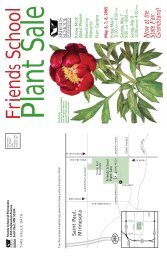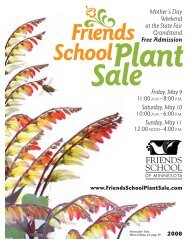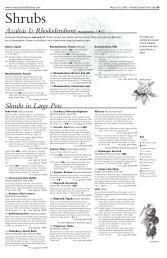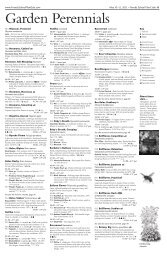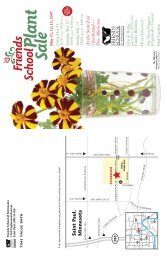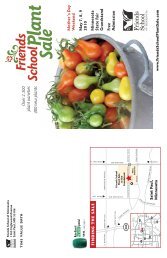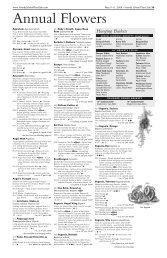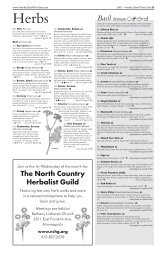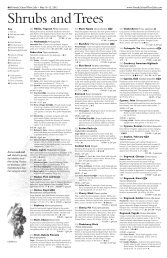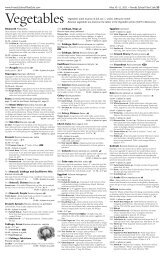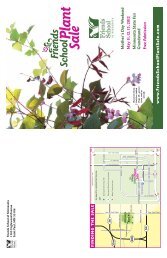View the 2013 56-page PDF here - Friends School Plant Sale
View the 2013 56-page PDF here - Friends School Plant Sale
View the 2013 56-page PDF here - Friends School Plant Sale
You also want an ePaper? Increase the reach of your titles
YUMPU automatically turns print PDFs into web optimized ePapers that Google loves.
www.<strong>Friends</strong><strong>School</strong><strong>Plant</strong><strong>Sale</strong>.com May 10–12, <strong>2013</strong> • <strong>Friends</strong> <strong>School</strong> <strong>Plant</strong> <strong>Sale</strong> 31<br />
Annuals<br />
Indoor/Outdoor<br />
<strong>Plant</strong>s †<br />
These taller plants are meant to be taken indoors for <strong>the</strong><br />
winter and put back outside again next year. Or <strong>the</strong>y can<br />
be used as annuals for tropical effect if you don’t have<br />
room to bring <strong>the</strong>m indoors.<br />
Angel’s Trumpet, Upright Brugmansia<br />
Tender woody tropical bush covered with huge, hanging, trumpet-shaped<br />
blooms. <strong>Plant</strong> in a tub to winter indoors. 긴<br />
$6.00—4” pot:<br />
A001 Red, B. sanguinea—Pendulous scarlet to orange 8–12”<br />
trumpets with yellow sides. Needs rich soil; shouldn’t be<br />
allowed to dry out. Fertilize regularly. Prefers cooler summers.<br />
Native to Peru. 96”h ∫<br />
$9.00—1 gal. pot:<br />
A002 Pink—Large 8” blossoms. Very reliable bloomer. 96”h<br />
A003 Banana, Abyssinian Ensete ventricosum ß<br />
Maurelii—Dwarf red Abyssinian banana with foliage that is<br />
flushed burgundy-red, especially in <strong>the</strong> new growth and when<br />
in full sun. Winters well in <strong>the</strong> house. Does not like to dry out.<br />
72–84”h Í∏<br />
$10.00—1 gal. pot<br />
Brush Cherry, Topiary Eugenia myrtifolia<br />
If you ever wanted to have one of those topiaries that are made<br />
up of sp<strong>here</strong>s of small leaves, <strong>here</strong>’s your chance. Tall and narrow,<br />
<strong>the</strong>y make an elegant statement. Í∏<br />
$17.00—6” pot: $39.00—3 gal. pot:<br />
A004 Two-sp<strong>here</strong>s ß A005 Three-sp<strong>here</strong>s ß<br />
Elephant Ears tropical aroids<br />
Easy to grow and over-winter indoors. Thrives in full sun and<br />
moist soil, but does well in shade, too. Í∏Óç<br />
$10.00—6” pot<br />
A006 Black Magic, Colocasia ß—Dramatic dusty purplish black<br />
foliage. 36–72”h<br />
A007 Blue Hawaii, Colocasia ß—Vibrant blue-purple veins and<br />
margins on green leaves. Stems and <strong>the</strong> veins on <strong>the</strong><br />
underside of <strong>the</strong> leaves are burgundy. 48”h ¥<br />
A008 Coffee Cups, Colocasia ß—Glossy olive green leaves with<br />
dark purple-black stems, beautifully cupped so that <strong>the</strong><br />
leaves catch <strong>the</strong> rain. 36–60”h<br />
$15.00—5.25” pot:<br />
A009 Mayan Mask, Alocasia ◊—Giant shiny green leaves<br />
with wavy edges and pale veins display purple-maroon<br />
undersides, especially in <strong>the</strong> new foliage which emerges<br />
upright. Grows quickly. Prefers afternoon shade. 72–96”h<br />
A010 Thai Giant, Colocasia ◊—Blue-green 60” leaves with pale<br />
veins, a powdery haze, and slightly ruffled edges. Turns and<br />
nods in a light breeze on thick gray-blue stems. Grows fast.<br />
Likes fertilizer: “Feed me, Seymour.” 84–108”h<br />
A011 Ginger, Variegated Shell Alpinia zerumbet<br />
Variegata—Striking yellow stripes on dark green leaves.<br />
Fragrant white flowers tinged pink with yellow lips and red<br />
throats. 48”h Í∏<br />
$11.00—1 quart pot<br />
Hawaiian Ti Cordyline<br />
Striking color and texture for a large container. Íç<br />
$14.00—5.25” pot<br />
A012 Electric Pink, C. banksii ß—Slim bright pink leaves with<br />
a ribbon of maroon in <strong>the</strong> center beg to be paired with colors<br />
like chartreuse or orange. Winter indoors. 24–48”h<br />
A013 Renegade, C. banksii x australis —Distinct tight clumpformer<br />
with arching dark purple to nearly black foliage<br />
and a glossy lacquered finish. 24”h<br />
$19.00—3 gal. pot:<br />
A014 Red Sister, C. terminalis ß—Leaves are plum and deep<br />
burgundy with neon pink. A variety of <strong>the</strong> plant that is traditionally<br />
used for grass skirts. Syn. C. fruticosa. 36–72”h<br />
See also CABBAGE PALM, NEW ZEALAND, <strong>page</strong> 33<br />
A015 Hibiscus, Tropical Braided Hibiscus ß<br />
Sunny City series—Large blooms with crepe-paper-like petals<br />
and glossy foliage. Three stems braided to form a small tree.<br />
Available in a range of colors, and <strong>the</strong>y should be blooming at <strong>the</strong><br />
sale, so you can choose <strong>the</strong> one you like. 36–48”h Í<br />
$15.00—6” pot<br />
A016 Mandevilla, Red Mandevilla<br />
Large trumpet-shaped blooms for a completely tropical look.<br />
On a 30” trellis. Best in a sunny position, but tolerates partial<br />
shade. Í<br />
$15.00—6” pot<br />
A017 Snake <strong>Plant</strong> Sansevieria trifasciata ß<br />
The classic houseplant with upright spears of green. A great<br />
vertical accent in a summer container. Unkillable. Up to 36”<br />
∏Ó<br />
$9.00—5.25” pot<br />
A018 Princess Flower Tibouchina grandiflora ◊<br />
Rich Blue—Huge dark green velvety leaves and large panicles<br />
of 3” violet-blue flowers. Will continue to bloom indoor all<br />
winter. 42–48”h Í<br />
$15.00—5.25” pot<br />
Succulents<br />
Succulents are fleshy-leaved plants<br />
that store water and so are adapted<br />
to dry conditions and containers. The<br />
ones below are not hardy in Minnesota, but you can winter <strong>the</strong>m indoors in<br />
a sunny window or under grow lights. When you bring <strong>the</strong>m outdoors in<br />
June, let <strong>the</strong>m gradually adjust to higher light levels.<br />
For more succulents, see also Moss Roses (<strong>page</strong> 37). In rare plants, see <strong>the</strong><br />
cactus (<strong>page</strong> 7). And don’t forget <strong>the</strong> perennial and native succulents:<br />
Prickly Pear (<strong>page</strong> 51), Hen and Chicks (<strong>page</strong> 15), Ice <strong>Plant</strong> (<strong>page</strong> 17),<br />
Spiny Star (<strong>page</strong> 22) and Stonecrop (<strong>page</strong> 21), as well as Aloe Vera in<br />
herbs (<strong>page</strong> 8).<br />
The heights are approximate. Succulents will grow smaller in small pots<br />
and larger in large pots.<br />
Aeonium Aeonium<br />
Forms a rosette of succulent leaves on a<br />
basal stem, resembling a miniature<br />
palm tree. Annual growth is 4–6” per<br />
year.<br />
$5.00—3.5” pot:<br />
A019 Garnet—Rose to dark red<br />
rosettes with some green.<br />
24–48”h Í<br />
$6.00—4” pot:<br />
A020 Kiwi ß—The rosettes are pale<br />
yellow in <strong>the</strong> center, with green<br />
middles and pinkish red edges.<br />
Small yellow flowers may bloom<br />
in <strong>the</strong> summer, but it’s <strong>the</strong> variegated<br />
leaves you really want.<br />
24–36”h ∏<br />
A021 Zwartkop—Dark purple (seemingly<br />
black) rosettes. Sounds sinister,<br />
but actually <strong>the</strong> plant has an<br />
amusing if somewhat dramatic<br />
personality that garden visitors<br />
are always attracted to.<br />
36–48”h Í<br />
A022A African Milk Bush<br />
Synadenium grantii ◊<br />
Large succulent from east central Africa<br />
with leaves in apple green splashed<br />
with maroon. Inconspicuous flowers.<br />
Easy to take care of, but will drop its<br />
lower leaves to tell you it’s being over<br />
or under-watered. Up to 20’ tall in <strong>the</strong><br />
tropics, and will grow several inches a<br />
month, but in a container with welldrained<br />
soil it will stay a manageable<br />
size <strong>here</strong>. Be very careful to avoid <strong>the</strong><br />
caustic sap which does not blister right<br />
away, but hours later. 48–72”h Í ¥<br />
$5.00—3.5” pot<br />
A022B Aloe, Fancy Aloe spp.<br />
Your choice from a variety of <strong>the</strong> desert<br />
natives with long, thick, spiked leaves.<br />
Well-drained soil. Excellent in containers<br />
or as a houseplant. 12–36”h Í∏ ¥<br />
$3.00—2.5” pot<br />
A023 Cactus, Fea<strong>the</strong>r<br />
Mammilaria plumosa<br />
Masses of soft white fea<strong>the</strong>ry spines<br />
make this one of <strong>the</strong> friendliest and<br />
most beautiful cactus plants. White<br />
flowers with strong sweet scent. Low,<br />
dense mounds. 6”h by 16”w Í<br />
$3.00—2.5” pot<br />
A024 Cactus, Paraguayan<br />
Ball Gymnocalycium friedrichii<br />
Excellent for a window with filtered<br />
sunlight Allow to dry out before watering.<br />
Keep dry and warm in winter.<br />
4”h ∏ ¥ $4.00—2.5” pot<br />
A025 Cactus, Peanut<br />
Echinopsis chamaecereus<br />
Cute, densely branched and ribbed cactus<br />
from Argentina. Numerous peanutlike<br />
offsets along <strong>the</strong> stems will root<br />
easily. In late spring, 1–2” red-orange<br />
flowers bloom. Moderate water and<br />
light shade in summer. In winter, let<br />
rest in a cool location with very little<br />
water. A great cactus for beginners.<br />
4–6”h Í<br />
$3.00—2.5” pot<br />
A026 Cactus, Smooth ◊<br />
Unknown species<br />
Thin smooth paddle-shaped pads that<br />
cluster in every direction appear to have<br />
no spines, but do have tiny ones.<br />
Grown for thousands of years as a fruit<br />
crop, its tender young pads are also eaten.<br />
Gigantic w<strong>here</strong> hardy, it is easy to<br />
grow in a container and bring inside for<br />
our winters. Propagates readily. Makes<br />
a curious and spectacular ornamental<br />
with its multiple “ears.” We think it<br />
may be ei<strong>the</strong>r Nopalea cochenillifera or<br />
Opuntia ficus-indica. If yours blooms, let<br />
us know <strong>the</strong> flower color! 72”h ÍÇ<br />
$6.00—4.5” pot<br />
A027 Cereus, Monstrose<br />
Cereus monstrose<br />
Monstrose cactus grows from random<br />
points and is covered in knobby bumps<br />
and whorls. Likes warm temperatures<br />
in winter; excellent for a windowsill<br />
garden. They prefer filtered light and<br />
dry conditions. Two varieties will be<br />
available. 12”h Í ¥ $5.00—3.5” pot<br />
Crassula Crassula<br />
Good container plants that thrive on<br />
neglect. Most prefer to be out of <strong>the</strong><br />
hottest noonday sun. Over-winter<br />
indoors. Í∏<br />
$3.00—2.5” pot:<br />
A028 E.T.’s Fingers, C. ovata ◊—<br />
Deep green 2” leaves with red tips<br />
that look o<strong>the</strong>rworldly. May produce<br />
tiny, pink, daisy-like flowers<br />
in late winter. Also called Hobbit’s<br />
Pipe, Gollum, and Shrek <strong>Plant</strong>.<br />
18–24”h<br />
A030 Assorted—Crassula range in size<br />
from less than an inch in height to<br />
many feet.<br />
A031 Dish Garden ß<br />
Four succulent or cactus plants in a<br />
self-contained desert garden for a sunny<br />
window. Cute! Í<br />
$9.00—4” ceramic pot<br />
Echeveria Echeveria<br />
Rosette-forming succulents in a range<br />
of colors, shapes and textures. Mexican<br />
native. Í∏ ç¥<br />
$3.00—2.5” pot:<br />
A032 Assorted—Your choice of<br />
interesting echeverias.<br />
$3.00—3.5” pot:<br />
A033 Perle von Nurnberg ß—Like<br />
pink roses growing directly out of<br />
<strong>the</strong> ground. 9”h<br />
Jade Tree Crassula ovata<br />
Jade trees are generally kept as house<br />
plants, but <strong>the</strong>y appreciate a trip outside<br />
in <strong>the</strong> warm months. Thick<br />
branches with smooth, rounded, fleshy<br />
leaves. Clusters of small scented white<br />
or pink star-like flowers. Í∏<br />
$9.00—6” pot:<br />
A034 Variegated ß—36”h<br />
$12.00—8” pot:<br />
A035 Classic ß—The classic jade<br />
plant. Good as a bonsai or grown<br />
to reach shrub proportions. May<br />
flower during <strong>the</strong> winter months.<br />
36”h<br />
A036 Mini, clump ß—Diminutive, but<br />
instead of a single tree form, it<br />
comes in a clump. 18–48”h<br />
A037 Lawyer’s Tongue<br />
Gasteria sp.<br />
Aloe relative whose thick, strap-shaped<br />
leaves spiral into a rosette with age.<br />
Scapes of sack-like blossoms appear in<br />
summer. Wonderful house plant; likes<br />
afternoon shade outdoors. 3–6”h Í∏<br />
$3.00—2.5” pot<br />
A038 Living Baseball<br />
Euphorbia obesa<br />
Peculiar is <strong>the</strong> word for this ball-shaped<br />
dwarf succulent, which resembles a<br />
stone a bit more than it does a baseball.<br />
8”h Í ¥ $4.00—2.5” pot<br />
A039 Living Stones Lithops<br />
Subtle colors of gray, brown, rust, green<br />
and pink combine with fantastically<br />
intricate markings and relatively large<br />
flowers. Lithops originate from South<br />
Africa and Namibia, w<strong>here</strong> <strong>the</strong> unusual<br />
pebble-like appearance of its leaves<br />
evolved to adapt to extreme heat and<br />
drought and to act as camouflage to<br />
make <strong>the</strong> plant less obvious to foraging<br />
animals. 2–4”h Í $3.00—2.5” pot<br />
A040 Pencil Tree Euphorbia<br />
Sticks on Fire—Strange branching<br />
plant like a skinny little cactus or coral.<br />
New stems are copper-red in cool<br />
wea<strong>the</strong>r and peachy-yellow in summer,<br />
<strong>the</strong>n age to shades of pink, pale orange,<br />
yellow and chartreuse. 12–24”h, much<br />
taller if overwintered multiple years. Í<br />
¥ $5.00—4.5” pot<br />
A041 Prickly Pear, Flat Leaf<br />
Opuntia<br />
Cute little cactus with very thin pads.<br />
12”h Í $2.00—2.5” pot<br />
A042 Prickly Pear,<br />
Variegated Treeform<br />
Opuntia monacantha variegata<br />
Multiple green and cream marbled flat<br />
pads Prefers morning sun. To 72”h Í<br />
$9.00—6” pot<br />
A043 Rose Pincushion<br />
Mammillaria zeilmanniana<br />
One of <strong>the</strong> most prolific bloomers<br />
among this group of spherical cactus.<br />
Avoid strong sun inside or out. 3”h<br />
Í∏<br />
$3.00—2.5” pot<br />
A044 Silver Sticks<br />
Calocephalus brownii<br />
Very cool...no leaves, but it looks like<br />
silver sticks! Wait until you see it.<br />
8–12”h Í∏ ç $2.00—2.5” pot<br />
A045 Squill, Silver ◊<br />
Ledebouria socialis<br />
Violacea—Pear-shaped above-ground<br />
succulent bulbs from South Africa. One<br />
bulb can produce many daughter bulbs<br />
until <strong>the</strong> original is surrounded, giving<br />
<strong>the</strong> entire little plant an intriguing family-of-cute-aliens<br />
look. The 4–6” lanceshaped<br />
leaves vary a lot in color and<br />
pattern, but are generally mottled green<br />
and silver with burgundy undersides.<br />
Summer flower spikes have many tiny<br />
green-white flowers. Usually kept in its<br />
own small container so you can see it<br />
up close. 6–10”h ∏Ó $6.00—3.5” pot<br />
Stonecrop Sedum<br />
These stonecrops are not hardy <strong>here</strong>,<br />
but are so beautiful you’ll want to have<br />
<strong>the</strong>m in your containers. Í<br />
$3.00—2.5” pot<br />
A046 Mediterranean, S. cepaea—Spikes<br />
of pinky-white, star-like flowers<br />
and whorled leaves. From all<br />
around <strong>the</strong> Mediterranean Sea.<br />
2–3”h ∫˝ ‰¥<br />
$4.00—3.5” pot:<br />
A047 Fine Gold Leaf ß—Trailing chartreuse<br />
foliage with tiny leaves.<br />
Drought tolerant and suited to<br />
containers. 2–3”h<br />
$5.00—4” pot:<br />
A048 Lemon Coral, S. rupestre ß—<br />
Spiky chartreuse foliage. Very<br />
vigorous. 6–10”h ∫Ç˝ ‰¥<br />
A050 Succulents, Assorted<br />
Choose <strong>the</strong> ones that you like from this<br />
mix of trailing and upright succulents.<br />
Í<br />
$3.00—2.5” pot<br />
A051 Zebra <strong>Plant</strong><br />
Haworthia attenuata<br />
Rosettes of spiky leaves banded or spotted<br />
with white. Greenish-white flowers.<br />
6”h ∏ $3.00—2.5” pot





